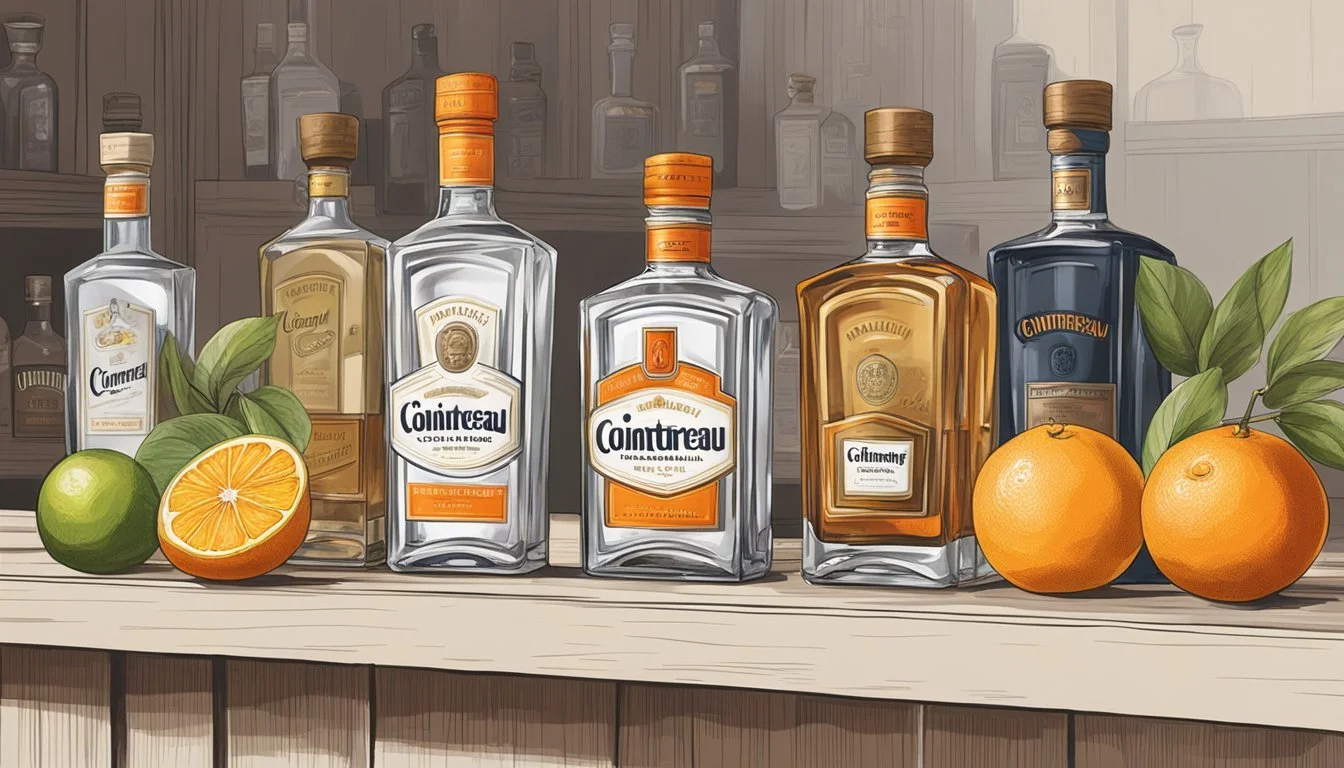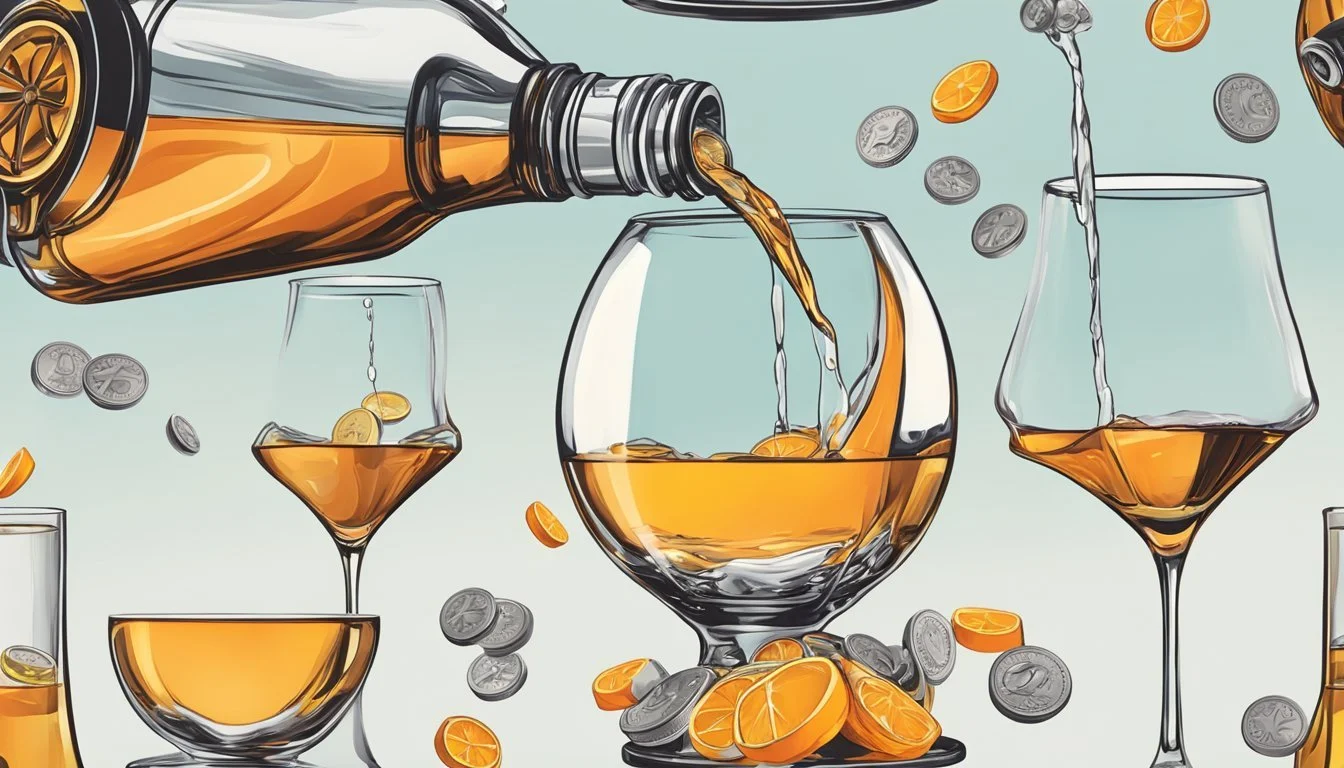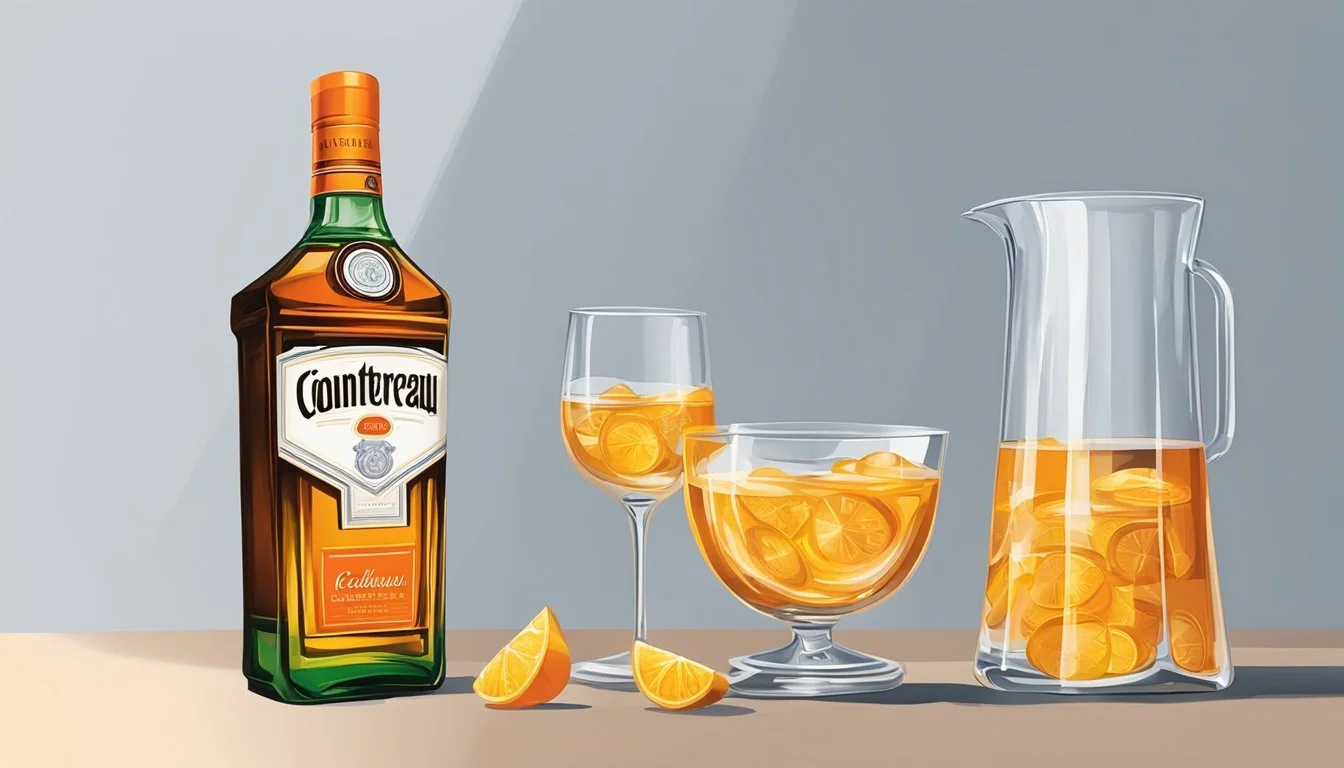How Many Servings of Cointreau Is Too Much
Understanding Safe Consumption
Cointreau, the popular orange liqueur, is often enjoyed in cocktails and can elevate any drinking experience. Containing 40% alcohol by volume, a single ounce of this triple sec delivers 93 calories and 6.8 grams of carbohydrates. Knowing how many servings of Cointreau are too much is essential for responsible alcohol consumption.
Health experts recommend no more than one to two alcoholic drinks per day for adults. With Cointreau, this translates to about 1 to 1.5 ounces per serving. Exceeding this amount can lead to excessive calorie and sugar intake, as well as increased alcohol consumption risks.
Given that a 1.5-ounce serving contains about 15 grams of sugar, consuming multiple servings quickly adds up. That's over half the World Health Organization's recommended daily limit for added sugars in just one serving. This makes moderation key when enjoying this flavorful liqueur.
Understanding Cointreau and Orange Liqueurs
Cointreau is a renowned French orange liqueur with a strong citrus flavor. This section covers the chemical composition of Cointreau, how it compares to other orange liqueurs, and its historical background and significance in the world of spirits.
Chemical Composition of Cointreau
Cointreau has a distinct flavor profile derived from the essential oils of sweet and bitter orange peels. The base spirit is usually distilled from sugar beets, providing a neutral backdrop to the intense orange aroma.
The spirit is 40% ABV (80 proof), making it as potent as many gins. One ounce of Cointreau contains approximately 93 calories, with no fats, proteins, or salt, but it does have 6.8 grams of carbohydrates, mostly from sugar.
Comparing Cointreau with Other Orange Liqueurs
Cointreau sets itself apart from other orange liqueurs like triple sec and Grand Marnier. While all feature orange as the primary flavor, Cointreau is colorless and has a higher proof. Triple sec, often less concentrated, varies in quality and proof.
Grand Marnier, another premium orange liqueur, features a blend of cognac and essence of bitter orange. This gives it a richer and darker profile compared to the clear, intense citrus notes of Cointreau. Both Cointreau and Grand Marnier excel in mixology and digestífs.
The History of Cointreau and Its Place in Spirits
The history of Cointreau dates back to 1849, when it was founded by Adolphe and Edouard-Jean Cointreau in Angers, France. The recipe, which has been passed down through generations, combines sweet and bitter orange peels to create its unique flavor.
Cointreau rapidly gained popularity and became a staple in many classic cocktails. Its versatile and sophisticated profile has ensured its continued prevalence in the world of mixology, overshadowing many other orange liqueurs.
Guidelines for Cointreau Consumption
When considering how many servings of Cointreau is too much, it's crucial to understand what constitutes a standard serving, the health implications of overconsumption, and the impact of its alcohol content on consumption limits.
Identifying Standard Servings
A standard serving of Cointreau is typically measured as 1 ounce. This serving contains approximately 93 calories, 6.8 grams of carbohydrates (sugar), and 9.5 grams of alcohol. With no fat, protein, or sodium, its primary nutritional concern is its alcohol and sugar content.
Given its 40% alcohol by volume (ABV), moderation is key. The recommended limit for alcohol consumption is up to one standard drink per day for women and up to two for men. This guideline helps minimize the risk of health issues associated with excessive drinking.
Potential Health Implications of Overconsumption
Excessive consumption of Cointreau can lead to several health risks. High alcohol intake increases the likelihood of developing liver disease, cardiovascular problems, and certain cancers. The added sugar in Cointreau can contribute to weight gain and associated metabolic issues.
Regularly consuming more than the recommended limit strains the liver due to its need to metabolize alcohol efficiently. Additionally, overindulgence can lead to impaired judgment and coordination, increasing the risk of accidents and injuries.
In terms of nutrition, while Cointreau contains no fat or sodium, the caloric content can add up quickly if multiple servings are consumed, potentially leading to obesity-related health problems.
How Alcohol Content Affects Consumption Limits
Cointreau's 40% ABV means that even small amounts can significantly contribute to one's overall alcohol intake. This high alcohol content requires careful monitoring of servings to maintain safe consumption levels.
Heavier consumption increases blood alcohol concentration (BAC) rapidly, which can impair mental and physical functions. For context, a BAC of 0.08% is considered legally impaired in many jurisdictions, and this level can be reached more quickly with a high-ABV drink like Cointreau.
It's essential to pace consumption and avoid mixing with other alcoholic beverages to stay within safe limits. Hydration and food intake can also help moderate alcohol's effects on the body.
Incorporating Cointreau in Cocktails
Using Cointreau in cocktails can elevate your drinking experience. Its complex, orange-infused flavor makes it a staple ingredient that complements a variety of spirits.
Classic Cocktail Recipes Featuring Cointreau
Several classic cocktails prominently feature Cointreau.
Margaritas are a prime example, combining Cointreau with tequila, fresh lime juice, and a salted rim for a refreshing drink. A standard margarita recipe might call for 2 oz tequila, 1 oz Cointreau, and 1 oz fresh lime juice, shaken with ice in a cocktail shaker and strained into a glass.
The Cosmopolitan, another favorite, includes vodka, cranberry juice, fresh lime juice, and Cointreau. This mix results in a stylish, balanced drink often garnished with a lime twist.
Mai Tais use Cointreau to enhance their tropical flavors, blending rum with lime juice, orgeat syrup, and simple syrup for a complex, layered taste.
Cointreau as a Versatile Cocktail Ingredient
Cointreau's versatility is evident in its ability to pair well with an array of bases like vodka, tequila, and rum.
It serves both as a primary spirit and a supporting modifier, capable of enhancing the profile of any cocktail. In a Sidecar, for instance, Cointreau blends with cognac and lemon juice to create a drink that is zesty and refreshing.
Its citrusy character makes it an ideal addition to drinks requiring citrus notes without added sweetness. In Long Island Iced Tea, Cointreau complements a mix of spirits, adding depth without overwhelming the other ingredients.
Mixing Techniques for Optimal Flavor
To maximize Cointreau's flavor in cocktails, proper mixing techniques are essential.
Using a jigger ensures accurate measurements, particularly in cocktails like margaritas and cosmopolitans, where balance is crucial. Shaking with ice not only chills the drink but also subtly dilutes it, allowing the orange notes of the Cointreau to harmonize with other flavors.
Garnishes such as a salt rim or a lime twist can enhance both the appearance and taste. Always strain your shaken cocktails into the glass to remove any ice shards, which could alter the drink's flavor profile.
In cocktails like the Mai Tai, layering ingredients ensures that the Cointreau's flavors come through in each sip, contributing to the drink’s complexity.
Responsible Drinking Practices
When drinking Cointreau, moderation and awareness are key. Establishments and bartenders play a crucial role in promoting responsible consumption.
The Role of Bartenders and Establishments
Bartenders and establishments are pivotal in ensuring safe drinking environments. They should be trained to recognize signs of overconsumption and intervene appropriately. Offering smaller serving sizes, such as 1 oz of Cointreau instead of larger portions, can help manage alcohol intake.
Educating customers on the strength of their drinks, especially with a liqueur like Cointreau that contains 40% alcohol by volume, is also essential. Providing water alongside alcoholic beverages can encourage hydration and slow down consumption.
Additionally, establishments should adhere to serving guidelines and policies designed to prevent excessive drinking. This includes denying service to visibly intoxicated individuals and promoting non-alcoholic alternatives.
Cointreau in Culinary Creations
Cointreau is a versatile ingredient in the kitchen, enhancing both desserts and savory dishes with its citrusy flavor. It is frequently used in baked goods and acts as a vibrant addition to sauces and glazes.
Desserts and Baked Goods with a Cointreau Twist
Cointreau can elevate traditional desserts with a hint of orange liqueur. Cointreau-infused cheesecakes offer a delicate citrus balance against the richness of cream cheese. In cookies, a splash of Cointreau alongside vanilla can create a complex flavor profile, turning simple treats into delightful surprises.
Additionally, cakes and cupcakes benefit from a Cointreau-soaked sponge, providing a moist, flavorful bite. Vegan bakers can also use Cointreau in sugar-free, dairy-free recipes, pairing the liqueur with ingredients like almond flour and coconut oil for an indulgent yet inclusive option.
Cointreau-Based Sauces and Glazes
In savory applications, Cointreau's sweet and tart profile shines in sauces and glazes. A Cointreau reduction sauce can complement poultry dishes, adding a zesty note that balances the meat's savory qualities. For a simple yet elegant addition to grilled meats, a Cointreau-glazed pork makes for a flavorful pairing.
Cointreau's versatility also extends to salad dressings, where it can replace or enhance citrus elements. Combining Cointreau with olive oil, Dijon mustard, and honey results in a bright, tangy vinaigrette, perfect for fresh greens.
Desserts and Entrées can both benefit from Cointreau's unique appeal, making it an indispensable ingredient in diverse culinary applications.
Non-Alcoholic Alternatives
For those looking to avoid alcohol while retaining the essence of Cointreau in their beverages, several non-alcoholic substitutes can provide a similar citrusy flavor profile and aroma. These options present a balanced approach to enjoying mocktails with the added health benefits of reduced alcohol consumption.
Mocktails Mimicking Cointreau's Flavor
Creating mocktails that mimic the distinctive taste of Cointreau requires careful ingredient selection. Fresh orange juice and orange extract are excellent choices, providing natural citrus flavors without alcohol.
A tablespoon of orange extract or zest can replicate Cointreau's bright aroma, while combining fresh juice with a touch of sparkling water adds effervescence, mirroring the complexity of traditional cocktails. Another creative option is orange syrup, which can be diluted with water to achieve the desired intensity. These substitutes allow for versatile mocktail recipes that cater to various preferences and dietary restrictions, including vegan options.
Finding Balance with Flavor and Health
Balancing flavor with health in non-alcoholic alternatives involves considering both taste and nutritional content. Orange juice, laden with vitamin C and other nutrients, serves as a healthy substitute. For those monitoring sugar intake, freshly squeezed options are preferable over commercially sweetened variants.
Adding natural sweeteners like agave syrup or honey can enhance flavor without compromising health goals. Additionally, integrating other citrus fruits such as lemon or grapefruit expands the flavor profile, offering depth and variety.
Non-alcoholic substitutes not only avoid the addictive compounds of alcohol but also contribute positively to overall wellness, making mocktails a delightful and health-conscious choice.
Nutritional Information of Cointreau
Cointreau is known for its distinctive orange flavor and is often served in cocktails. It is important to understand the nutritional content to make informed consumption choices.
Calorie Content and Nutritional Breakdown
A single ounce of Cointreau contains approximately 93 calories. It has no fat, saturated fat, protein, or fibers. The primary nutritional components are alcohol and sugar. Each serving provides around 6.8 grams of carbohydrates, largely due to its sugar content.
Nutritional Data per 1 oz serving:
Calories: 93
Carbohydrates: 6.8g (sugar)
Alcohol: 9.5g
Fat: 0g
Protein: 0g
Sodium: 0g
Cointreau does not supply significant amounts of vitamins, minerals like potassium, calcium, or any dietary fiber.
Comparing Cointreau to Other Alcohol Nutritional Values
When compared to other alcoholic beverages, Cointreau's calorie count is relatively high. For instance, vodka has about 64 calories per ounce with no sugar content, while whiskey contains 70 calories per ounce, also without sugar. Liqueurs like Baileys Irish Cream present around 97 calories per ounce but include fat and protein due to the cream component.
In terms of sugar content, Cointreau has more sugar than spirits like gin or tequila, which typically have negligible sugar content. The presence of sugar and higher-calorie content can make Cointreau a less desirable option for those monitoring calorie intake or sugar consumption.
This comparison helps highlight that although Cointreau offers a unique flavor, it also comes with a higher sugar and calorie content, making moderation important.
The Cultural Impact of Cointreau
Cointreau, a notable orange-flavored liqueur, has had a significant influence on the global spirits market and cocktail culture. Its presence in bars and restaurants worldwide highlights its cultural significance and traditions.
Cointreau in the Global Spirits Market
Cointreau has established itself as a prominent player in the global spirits market. Originating from France in the mid-19th century, it quickly gained international recognition. The brand's ability to maintain quality and authenticity while adapting to changing market demands has kept it relevant for over a century.
Cointreau Noir, a unique blend of Cointreau and Cognac, exemplifies the brand's innovative streak. This product showcases the company’s dedication to offering diverse options to consumers. With over 300 international awards, the heritage and recognition of Cointreau underscore its role in shaping the spirits industry.
Influence on Cocktail Culture
Cointreau's bold flavors and versatility have cemented its place in cocktail culture. Classic cocktails, such as the Margarita and the Cosmopolitan, rely heavily on this liqueur for their distinct taste. Its ability to enhance flavors and provide balance makes it an essential ingredient for bartenders and mixologists.
The cultural significance of Cointreau extends beyond its use in drinks. It has become a staple in many bars and restaurants, embodying both tradition and modernity. Its presence in cocktail recipes highlights an enduring legacy, making it a beloved choice for many.










